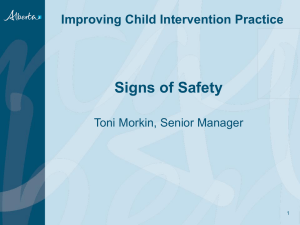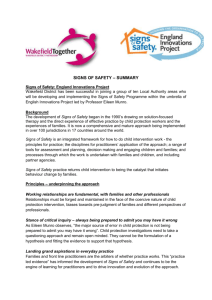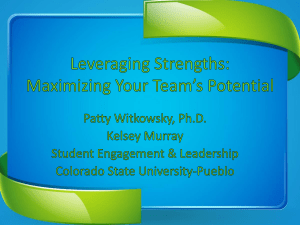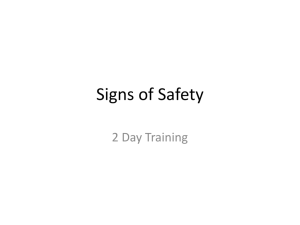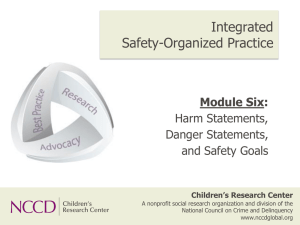signs of safety - London Safeguarding Children Board
advertisement
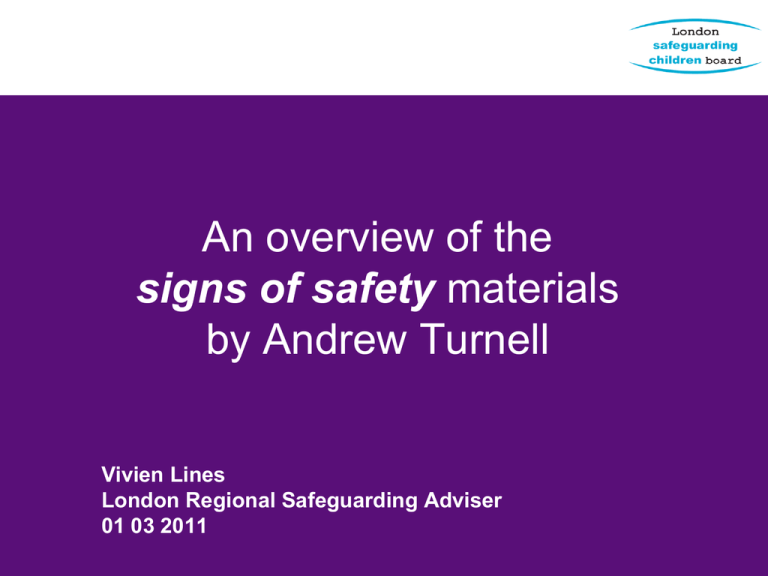
An overview of the signs of safety materials by Andrew Turnell Vivien Lines London Regional Safeguarding Adviser 01 03 2011 US government’s 1991 National Commission on Children “If the nation had deliberately designed a system that would frustrate the professionals who staff it, anger the public who finance it, and abandon the children who depend on it, it could not have not done a better job than the present child welfare system.” Background • Western Australia in the 1990s • Munro in England in 2011 • Desire to move away from an overuse of policy and procedure • To on-the-ground human practice that makes a constructive difference for professionals and families, and creates meaningful safety for children in high-risk cases • A purposive, positive focus for child protection work that is energising and affirming for practitioners and agencies… The SoS assessment framework • A process of creating a map of the circumstances surrounding a vulnerable child • A mechanism to arrive at a destination • Rigorous, sustainable, everyday child safety in the actual home and places in which the child lives • Rather than try and assert a definitive truth, ask penetrating, rigorous questions focused on the four domains of worries, strengths, goals and judgment. Gardner, 2008 and DSCF, 2009 • Signs of Safety recognised as a strengths based approach alongside an exploration of danger and risk • Addresses the problem that; ‘the recent emphasis on strengths based approaches and the positive aspects of families (for example in CAF) arguably discourages workers from making professional judgments about deficits in parents’ behaviour which might be endangering their children’. (DSCF 2009, p.47). Three principles • Constructive working relationships; between professionals and family members, and between professionals themselves • Thinking critically; all processes that support and inform practice foster a questioning approach or a spirit of inquiry as the core professional stance of the child protection practitioner • Rigour, skillfulness and greater depth of practice; by locating it in what on-the-ground good practice with complex and challenging cases looks, smells and lives like. Importance of risk assessment • Child protection risk assessment is often dismissed as too judgmental, too forensic and too intrusive • The frontline practitioner who hopes to practice collaboratively is currently caught between strengthsbased, support-focused aspirations and the harsh, problem-saturated, forensic reality • A risk-averse interpretation of the forensic child protection imperative consistently leads to defensive intervention and the escalation of a defensive case culture • The best child protection practice is always both forensic and collaborative Comprehensive Risk Assessment Family Knowledge Network and Culture Danger Balanced Assessment of Risk Safety Professional Knowledge Network and Authority ©2000Andrew Turnell PO Box 56 Burswood WA 6100 Australia, aturnell@iinet.com.au Building on professional knowledge • Is simultaneously forensic in exploring harm and danger while at the same time inquiring into strengths and safety. • Brings forward clearly articulated professional knowledge while also equally eliciting and drawing upon family knowledge and wisdom. • Is designed to always undertake the risk assessment process with the full involvement of all stakeholders, both professional and family. • Is naturally holistic since it brings everyone, (both professional and family member) to the assessment table. Questions and thoughts… • Implications locally? • Local strengths/opportunities? • Areas for development? Signs of safety • Maps the harm, danger, complicating factors, strengths, existing and required safety and a safety judgment in situations where children are at risk of harm • Is the organising map for child protection intervention from case commencement to closure. • At its simplest contains four domains for inquiry: 1. What are we worried about? (Past harm, future danger and complicating factors) 2. What’s working well? (Existing strengths and safety) 3. What needs to happen? (Future safety) 4. Where are we on a scale of 0 to 10 (where 10 means there is enough safety for child protection authorities to close the case and 0 means it is certain that the child will be (re)abused). Key SoS disciplines • A clear and rigorous understanding of the distinction between past harm, future danger and complicating factors • A clear and rigorous distinction made between strengths and protection; ‘safety is regarded as strengths demonstrated as protection (in relation to the danger) over time’ • Rendering all statements in straight-forward rather than professionalised language that can be readily understood by service recipients • As much as possible all statements focus on specific, observable behaviours • Skillful use of authority • An underlying assumption that the assessment is a work in progress rather than a definitive set piece A culture of appreciative inquiry • Focusing on successful, rather than problematic, behaviour is a powerful mechanism for generating change • Focusing forensically on the detail of what works, does not, as some fear, minimise problems and dysfunctional behaviour, quite the reverse • Inquiring into and honouring what works (with families and practitioners) creates increased openness and energy to look at behaviours that are problematic, dysfunctional or destructive. Practice depth… • Moving from conveyor-belt practice- characterised by responsiveness to efficiency drivers, getting cases through the system, meeting targets, speedy casework resolution and general compliance with policy and practice guidelines. • To reflective practice- characterised by critical reflection on issues, quality practice decision-making and interventions, depth of analysis, engagement with families and responsiveness to their needs while maintaining a child protection focus, mobilising supports and resources and access to critical supervision. Chapman and Field (2007) When we think about the situation facing this family: What are we Worried About? What’s Working Well? What Needs to Happen? On a scale of 0 to 10 where 10 means everyone knows the children are safe enough for the child protection authorities to close the case and zero means things are so bad for the children they can’t live at home, where do we rate this situation? (If different judgements place different people’s number on the continuum). 0 10 CP Conferences using SoS • Shifts the balance of power • Significant change in the approach of chairs • Importance of multi-agency ownership and engagement • Should have a system wide impact • The focus must be on risks • Requires professionals to synthesise and analyse information • Develops intervention plans rather than monitoring plans – requires different skill set The conference set up Strengthening Families Framework Danger/Harm GENOGRAM/ECOMAP ℴ Detail re: incident(s) Bringing the family to the attention of the agency. ℴ Pattern/family history Risk Statements • Strengths demonstrated as protection over time ℴ Pattern/history of exceptions (Grey Area) ℴ Risk to child(ren) ℴ Context of risk Complicating Factors ℴ Condition/behaviours that contribute to greater difficulty for the family ℴ Presence of research based risk factors Safety Safety Statement/ Outcomes •Description of the child’s care experience in positive terms Outline Plan 1. Keyworker 2. Visiting frequency 3. Outcomes 4. Core Group – who? 5. Core Group dates 6. Safety bottom lines 7. Review CPC date Strengths/Protective Factors ℴ Assets, resources, capacities within family, individual/community ℴ Presence of research based protective factors Lohrbach, S. & Sawyer, R (2004) Creating a constructive practice: family and professional partnership in high-risk child protection case conferences. Protecting Children, 19(2): 26-35. What’s different? • • • • • • • • Chair meets family first Layout of room Refreshments Style of chairing Family helped to complete genogram Succinct presentation of information Family gets opportunity to respond Clear and transparent focus on risk, danger, harm, complicating factors and safety • Risk statement • Plan – focus on bringing about change • Decision last Questions and thoughts… Child protection conferences locally; • Achieving their purpose? • Current effectiveness? • The role of CP Chairs? – Active – Facilitative – Directive – Challenging – Enabling Moving to safety planning • Current CPP approach leans towards service planning; important in creating change but a list of services not a safety plan • SoS focuses on the purpose of professional intervention being to create and ensure the children are safe in their daily life • Safety is regarded as the specific arrangements of everyday life that ensure a child is protected over time in situations where they may have previously been harmed or in situations where they are at risk of being hurt. SoS Safety planning • The goal is is to arrive at everyday changes in family living arrangements that show the child is safe • Focus on knowing whether the child is safe rather than attendance in services • Plans set out ‘the what’ and ‘the how’ • Professionals clearly defining what they want • Articulating straightforward danger statements which provide the foundation to determining what the professionals need to see to satisfy them that the child is safe in every day life Creating safety plans • All professionals need to be clear about who is taking the lead with the family • Sustain the working relationship with the family and the network – Using language everyone can understand – Agreement about future safety is the bottom line – Pay attention to what’s working well • The best CP practice is forensic and collaborative; focus on seriousness and draw on hope… What do parents say? • What enables them to do this difficult work? • Key professionals who; – Were honest and straightforward about the problems and what they wanted – Gave the parents hope they could get their children back – Focused on their strengths. Involving children • Development of tools and processes with practitioners • Designed to more actively involve children in child protection assessment • In understanding why professional intervention has happened • Use of words and pictures explanations • Child relevant safety planning. Safety goals and safety plans • Safety goals - an articulation of the exact things the statutory professionals need to see to be satisfied that this children are safe • Safety goals are what needs to be achieve • The safety plan is how those goals can be achieved. Requires skillful use of authority, purposive questioning and vision-building to motivate parents that specific safety plans can be created to get the job done. Example safety goals “We want to tell you what we need to see to be satisfied the children are safe and also to ask you for your best ideas about what needs to happen. Should we tell you what we think first or should we look at what you think needs to happen?” “Given that child protection are worried you will use drugs again and wont feed and care for the baby what do you think needs to happen to show then nothing like this can happen in the future?” The safety plan • Developing the rules to create safety • Requires a lot of thought! • Usually requires significant behavioural change on the part of the family • Importance of involving a network around the family to build safety • Identify the issues and challenges which get in the way of creating an effective, lasting plan • Involve the network in solving the issues • Identify and monitor triggers and difficulties Monitoring Progress • Create a sense of progress and achievement – so parents feel rewarded for their efforts • The best way to secure change is for professionals to assist parents to notice and detail their successes and for the professionals to honour them for their efforts. • The more the professionals do this, the more the parents and the network will open up about the difficulties they are experiencing in implementing the plan. Conclusions “Whatever services parents participate in, the real action on child safety happens in the home” • Approaching safety planning with a lively rather than pessimistic sense of scepticism is an invaluable resource for building the rigour and detail of the plan with the family • The most important aspect is that the plan is co-created with the family and an informed support network, it is operationalised, monitored and refined carefully over time and the commitments involved in the plan are made interactionally by the parents in front of their own children, kin and friends. Use in England… • To improve decision making in child protection • The organizing framework within collaborative conferencing • Viewed as especially useful with neglect because: – Parents say they are clearer about what is expected of them and receive more relevant support – The approach is open and encourages transparent decision-making – Professionals had to be specific about concerns for the child’s safety – This encourages better presentation of evidence – Visual use of scales to demonstrate risk and protective factors – Once set out the risks did not have to continually be revisited – The group could acknowledge strengths and how to achieve safety – Strong working relationship between worker and parents – Strong focus on parental and family strengths – Sustained and detailed exploration of what exactly safe parenting looked like and how it could be achieved – Time to build the relationship and do the casework. (Gardner, 2008, p78). Denmark: Three year project • Practitioners provided with more useful tools and skill set (75%) • Increased practitioner focus on the family’s resources (72%) • Increased practitioner’s inclusion of family’s strategies and solutions (55%) • Practitioners gave families more responsibility (49%) • Regular use of Signs of Safety at team meetings (79%) • Used Signs Of Safety framework together with families (69%) • Used Signs Of Safety framework at network meetings with other professionals (66%) • A cohort of 139 families who received intensive services and were assessed as having a high likelihood that the children may need to be placed in care were compared to a control group. • The Families in the Centre cohort had a lower proportion of children taken into care – 15% removals compared to 42% in the control group - and the cost/per family serviced was significantly reduced. Process of change • Training staff in new ideas and practices is simply the first step of organisational learning and implementation. • For training to make a difference, the ideas and practices must be supported by supervision and ongoing organisational processes that support and embed the new training and practices • Sustained organisational commitment to an organisation-wide ‘learning journey’ Implementation Key considerations; • What, when and how! – what’s right for you… • Presentation and discussion at LSCB • Role of CPAs and development needs • Development needs of social workers, TMs and partners • Practicalities - Report and minutes formats, room, whiteboard and refreshments • THOUGHTS and questions…!! To see it in action… • Brent open day • http://www.westberks.gov.uk/index.aspx ?articleid=12092 • http://www.signsofsafety.net/
